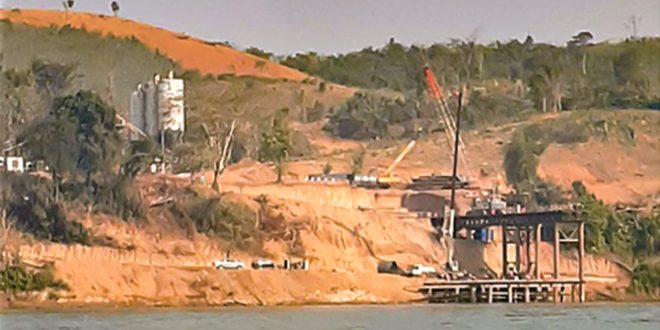Villagers in western Laos awakened in a panic final week to the sound of staff blasting rock to arrange for the constructing of a dam that will submerge their properties on the Mekong River.
They have been distressed as a result of the federal government has not clarified its relocation plans for them, or supplied particular compensation.
“The authorities haven’t said anything about the relocation or the compensation, but I see [Chinese workers] are working in the water, blasting rock in the river,” one resident of the district, known as Pak Lay in Xayaburi province, close to the Thai border, stated Thursday.
“I think that they’re building a bridge across the Mekong River,” he stated, asking to not be recognized for safety causes. “Because of the construction, we can’t fish anymore and boats can’t pass through anymore either.”
The issue is a typical one in Laos. Because the nation seeks to develop, construct roads and dams and harness the mighty Mekong for hydroelectric energy, authorities are inclined to neglect the wants and livelihoods of people that shall be straight affected, in addition to the environmental influence.
Native communities in addition to environmental and humanitarian teams have stated the Pak Lay Dam is anticipated to drive the relocation of some 1,000 households from 20 villages and hurt the encompassing ecosystem.
Nonetheless the Lao authorities seems lifeless set on continuing with the US$2 billion Chinese language-led challenge, which it hopes will carry the impoverished nation nearer to its aim of turning into the battery of Southeast Asia.
Inexperienced gentle
The residents’ feedback got here on the identical day that an official with the Lao Ministry of Power and Mines instructed Radio Free Asia that workers with China’s Sinohydro Corp. had begun constructing infrastructure for the Pak Lay Dam.
“The government has given the green light to the Chinese company to begin the construction of the basic infrastructure, including an access road and a bridge this year,” stated the official, who declined to be named as he was not licensed to talk to the media.
“According to the plan, the company is going to start building the actual dam early next year” and full it in 2029, he stated.

Native residents decried the neighborhood’s lack of say within the decision-making course of, and expressed concern about what sort of influence the dam could have on their lives.
“We villagers have no choice but to comply with the policy of the [ruling Communist] party and government,” stated one other villager from Pak Lay. “We want to oppose the project, but we can’t … fight against the party and government.”
“Of course we’re concerned about the relocation, the compensation and our [future] living conditions,” he stated. ”We don’t understand how a lot [the authorities] pays for our losses and we don’t know whether or not our dwelling situations shall be higher or worse after the dam.”
Relocation earlier than compensation
Laos has a grand plan to construct dozens of hydroelectric dams alongside the Mekong and its tributaries and promote round 20,000 megawatts of electrical energy – sufficient to energy practically 2,800 U.S. properties for one 12 months – to neighboring nations by 2030.
The Pak Lay Dam, anticipated to generate 770 megawatts, and the Pak Beng Dam in northern Oudomxay province, are two of the most recent. The latter is anticipated to displace round 6,700 folks dwelling in 25 villages.
In November 2021, Thai energy authorities agreed to buy energy generated by the 2 dams, each situated 60-80 kilometers (35-50 miles) from the Thai border, and by the Nam Gneum 3 Dam on Nam River.
The Lao Ministry of Power and Mines official instructed RFA final week that whereas the ability buy settlement for Pak Lay Dam has but to be finalized by the Electrical energy Producing Authority of Thailand, the Lao authorities needs Sinohydro Corp. “to be prepared for the construction of the dam as soon as the [agreement] is signed.”
Villagers worry being shortchanged within the compensation they obtain for his or her losses, as produce other Laotians affected by hydropower dam initiatives.
An official with Xayaburi’s Pure Assets and Atmosphere Division instructed RFA final week that his company remains to be within the means of finding farmland for the residents who shall be displaced. As soon as a website is procured, the federal government will start constructing new properties for these affected, he stated.
“When the relocation is complete the dam construction will begin, and only then can we talk about the compensation and the social and environmental impact – that’s the government’s policy,” stated the official, who spoke on situation of anonymity.
The Xayaburi official stated that the federal government is obligated to tell the neighborhood in regards to the potential influence of the dam “in order to avoid conflict later,” though it was not instantly clear how a lot info had been offered to the Pak Lay villagers.
“If the dam is going to be built, we as local authorities will have to do our job according to the plan, which will include clearing land, building resettlement villages and improving living conditions for the affected villagers,” he stated.
The official didn’t present particulars of how the federal government plans to compensate the villagers or give a timeframe for the method.
Standing of settlement unsure
Within the meantime, the Thai authorities has but to verify to members of the nation’s NGO neighborhood whether or not it would proceed with an settlement to buy electrical energy from the Pak Lay challenge, in response to Hannarong Yaowalers, chairman of the Integration Water Administration Basis in Thailand.
“However, in general, I think that if the Lao government is moving this project forward, [the Lao government and investors] may have gotten the necessary funding for the construction,” he stated. “They are unlikely to care about complaints [about the impact on the environment and fish population] previously lodged by the NGOs.”
Translated by Max Avary. Edited by Joshua Lipes and Malcolm Foster.
#asiannews #asian_news

